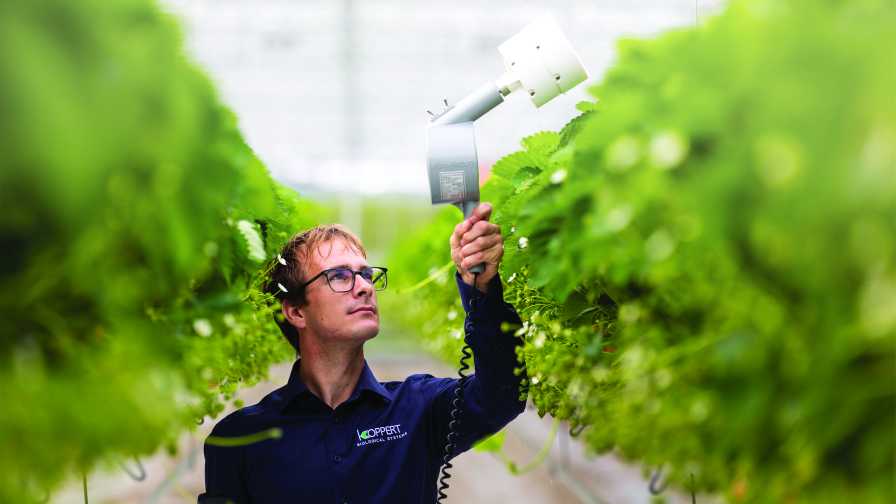Biocontrol Application Mistakes to Avoid in Your Crops

For optimal biocontrol application, products must be used at the right stage of development in a pest and/or disease life cycle to maximize efficacy.
Photo courtesy of Koppert Biological Systems
Biocontrol application mistakes add up in terms of lost time and money, not to mention crop losses due to ineffective control of the targeted pest. Many biocontrol products work great when used in accordance with the manufacturer’s direction. But when applied incorrectly, compromised efficacy and inadequate coverage can occur.
Here are three mistakes to avoid when applying your biocontrols.
1. Rigging Up Your Own Device
The equipment you choose to apply your biocontrols is critical to your success. Beware if you have plans to put your own dispersal system together. You may harm or stress the insects you are trying to disperse, compromising their performance.
“Although growers are very creative in rigging up their own systems, they often skip the step of making sure that the insects are not compromised in the process,” says Danny El-Aaidi, Sales Manager for Koppert Biological Systems. “This is especially relevant when any type of force, suction, or pressure is used to disperse the biocontrol. Rig up your own dispersal system, and you run the risk of harming the insects you’re trying to disperse. In addition, certain insects are just more sensitive than others, and you need to know which ones fall into that category.
2. Timing Your Applications Wrong
Timing is everything. Biocontrol products must be used at the right stage of development in a pest and/or disease life cycle and during the right environmental conditions in the field to maximize efficacy.
“Many biocontrol products are live organisms and require time to populate at levels in or on the target pest to deliver the best efficacy. Depending upon the biocontrol product, this can take a few minutes or up to 72 hours for control to be realized,” says Mike Allan, Certis USA Vice President, North America.
Allan adds that understanding the mode of action and how, when, and where biocontrols should be applied is essential to maximize success from a biocontrol application.
3. Mixing Product Inadequately
Make sure the dispersal product you use for biocontrol application has the proper agitation capabilities to keep a product mixed well, or you will get uneven introduction. Also, nematodes and other microorganisms applied in water require oxygen to survive. You must take precautions with stock and tank solutions to provide adequate aeration during the application process. And don’t forget about tank mix compatibility. Not all biocontrols can be tank mixed, so it’s prudent to familiarize yourself with the compatibility information for the specific products you plan to use.
Precision Biocontrol Application Via Sensor Technology on the Horizon
Biocontrol application devices have progressed from traditional hand-dispersal methods to simple handheld blowers, fully automatic blowing devices, tractor- and rail-mounted devices, and high-tech drones. Meanwhile, there have been many advancements in monitoring or scouting systems that track pests, weeds, and disease.
Sensing technologies are the perfect fit for biologicals because these products work best when applied preventatively at early stages of disease or before pest pressure rockets out of control.
“The ability to identify pest, weed, and disease pressure with sensing technology takes away a lot of the guesswork when scouting a crop where timing and weather play a big factor in the success for both biologicals and conventional control products,” Allan says.
In the future, a combination of application devices with monitoring or scouting systems technologies could be the key to precision delivery of biocontrols. It’s just a matter of time before the technology is available for biocontrol application.
“The scouting programs are making pest pressures visible, and when linked with the application devices, it’s theoretically possible to apply what is needed, where it is needed,” El-Aaidi says. “To do this automatically is still under development; however, farmers are already making applications in line with this. For example, they drive the tractor at half the speed in hot spots, thus doubling the introduction rates with a Koppert rotobug in those areas. In the same way, drone flight patterns can be changed based on the pressure.”
4 Steps to Vet Biocontrol Application Devices
There is a lot that can go wrong with the application of beneficials. So before you start using dispersal devices for biocontrol application, El-Aaidi suggests you do the following:
- If you already have a biological program in place that works for you, make sure that using application devices is the only variable you are changing at the time.
- Partner with a company that can provide you with the help you need to mitigate all possible points of failure.
- Work directly with a company that provides both the products and the services. The more parties involved (farmers, pest control advisers, third-party applicators, manufactures of introduction devices, etc.), the more difficult it becomes to find out why an application did not work the way it was supposed to.
- Make sure the manufacturer of the introduction device has done their homework. Ask for trial data. Ensure they have spent as much time on verifying the effects of the application technology on the insects and their ability to establish and thrive as they have on the engineering of the device.










